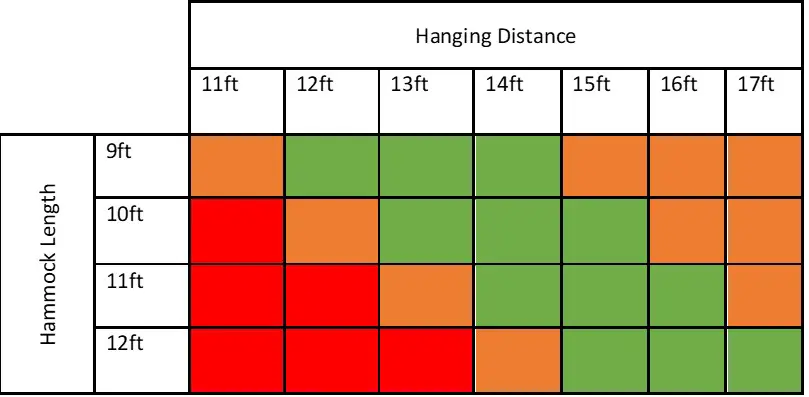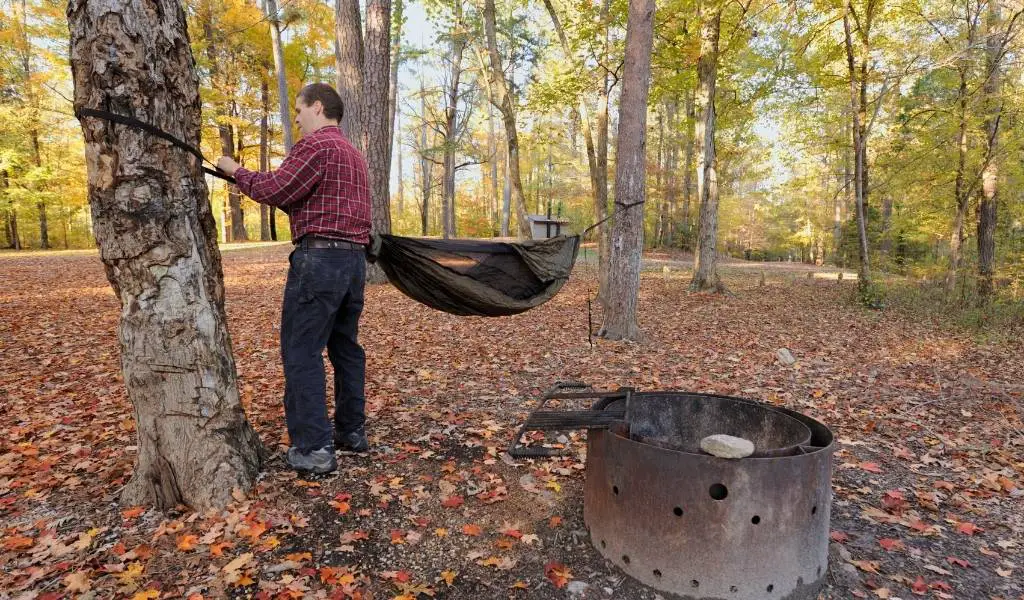Disclaimer: As an affiliate I may earn a commission on any qualifying purchases, including those from Amazon.com, at no extra cost to you – read more.
Whether you’re putting up a hammock in your backyard or heading out on a multi-day backpacking adventure, the most common way to hang a hammock is between two trees.
But, finding the perfect place to set up is often easier said than done. The main question you’ll be wondering is how far apart should the trees be for a hammock?
The distance between trees will depend on the size of your hammock, as a minimum, it should be at least 2ft longer than your hammock length from ring to ring. Typically, a distance of 12-15ft between trees is ideal for a gathered end hammock.
This length can be shorted for spreader bar hammocks which do not sag as much.
Keep reading for more tips on how to choose the perfect hanging spot and how high to hang your hammock.
How Far Apart Should Hammock Trees Be?
The minimum distance between trees should be 2ft longer than the full length of the hammock from ring to ring. However, I like to allow a little extra room for the straps, and to get the right sag, I’ll usually look for a space that’s 3-4ft longer than the hammock.
I’ve put together this helpful table to show the optimum hanging distance between trees:

Note: The length I am referring to is from ring to ring, it’s worth getting your hammock out and laying it flat on the ground to measure this as the manufacturers often use bed length.
Remember, if you’ll be hanging a tarp, you should also ensure that the hanging distance is longer than the tarp.
When choosing trees, there are other considerations to keep in mind as well as distance apart, these are:
- Loose branches above – Look out for trees with loose branches, these are often referred to as widow makers as they have the potential to cause harm if there is a storm or strong winds and they fall.
- Tree strength – It should go without saying that the tree needs to be strong enough to support a hammock. This means no dead trees and the diameter needs to be suitable, more on this in the next section.
- Natural windbreakers – Don’t underestimate wind chill and the effect it can have on you at night. Hopefully, if you’re camping out, you’ll have come prepared with an underquilt. But setting up your hammock near natural windbreakers such as bushes or shrubbery can help you stay warm at night.
Tip: Using hammock straps is fine for short-term hammocking, but if you’re hanging a hammock more permanently, it’s best to screw a hook into the tree. This will ensure it stays healthy, whereas a permanent strap around it can prevent growth and even result in your hammock killing the tree.
What About Spreader Bar Hammocks?
Whilst gathered-end style hammocks are the most popular for camping and for hammocks in the backyard, there are also spreader bar hammocks to think about.
The minimum distance for hanging a spreader bar hammock is equal to the length of the hammock from ring to ring.
This is different from my recommendation for gathered-end hammocks because the spreader bars give them an open design and reduce the amount of natural sag when you are lying in them. For this reason, they need to be more taut.
Spreader bar hammocks give you a much flatter lay which is more like a bed, this is ideal for side sleepers or those wanting a better view of their surroundings.
Remember, the total length must be from ring-to-ring when the hammock is laid out flat. Spreader bar hammock specs often won’t account for the suspension when providing the length so you should measure it yourself to be sure.
How Big Should a Tree Be to Support a Hammock?
There is no minimum tree size for hanging a hammock because it depends on the species and the strength, however, 6 inches is always a good size to aim for.
The main thing you need to keep in mind is whether the tree is sturdy enough to support your weight. Not just whether or not it will fall down, but whether it is likely to move at all once you get in your hammock.
If the tree sways even slightly, your perfectly hung hammock could end up with the wrong sag, or even worse, on the floor.
What is the Best Height to Hang a Hammock?
Now that you’ve found two trees that are the optimum distance apart, it’s time to think about how high you’ll need to hang the hammock in order to get the optimum amount of sag.
The hanging height is directly related to the distance between the trees. The wider the distance, the higher you’ll need to hang your hammock to keep off the floor.
The below table shows how high you should hang your hammock between trees:
| Hanging Distance Between Trees (feet) | Hanging Height (feet) |
| 11’ | 4’8” |
| 12′ | 5′ |
| 13′ | 5’4” |
| 14′ | 5’6” |
| 15′ | 5’10” |
| 16’ | 6’1” |
| 17’ | 6’5” |
| 18’ | 6’8” |
| 19’ | 7’ |
| 20’ | 7’3” |
This table is based on the average adult weight and a recommended 30° sag in your hammock.
Remember, you can always adjust the height of your hammock once you have hung it if you are struggling to get in or find that you are touching the floor once in it. To do this, simply loosen the straps and slide them up or down accordingly.
Again, this will be different for spreader bar hammocks which can be hung about 1 foot lower across the same distance.
Hammock Hang Calculator
If you would like to get a more accurate understanding of the required distance, height, and forces at play on your hammock, I recommend you get the hammock hang calculator app.
How does the calculator work?
The calculator has been designed using the physics of a hammock to work out exactly how much tension and force are being applied to different parts of the set up such as anchor points, suspension lines, and the hammock itself.
It’s the only hammock hang calculator I know of that provides such detailed information and well worth the $2 price tag, especially as it can be used offline when you’re out in the wild.
Hanging a Hammock When Trees Are Too Far Apart
When the trees are too far apart to hang your hammock, you can use longer hammock straps such as the Kammok Python. It’s also advisable to use a ridgeline when hanging your hammock across a long distance.
A ridgeline runs across the top of your hammock from one ring to the other, it ensures that the hammock maintains enough sag no matter where it is hung.
This can be essential for long distances as the hammock can wind up with an angle far smaller than the recommended 30° sag.
Keep in mind that the further the distance between the trees, the higher you’ll need to hang the straps to ensure your hammock doesn’t touch the floor.
Related Questions
Can You Hang a Hammock From a Tree Branch?
No, you shouldn’t hang your hammock from tree branches, you should always hang it from the tree trunk. This is for both sturdiness and to ensure you get the correct angle. It’s much harder to get the desired sag when hanging from a branch.
Oftentimes, it can be tempting to use the trunk and branch of the same tree to hang your hammock, however, this is generally a bad idea as the
How Far is Too Far For a Hammock?
This comes down to how high you’re able to hang your hammock from the trees. Even the tallest of folks will struggle to hang a hammock higher than 7ft without climbing the tree.
With this in mind, the maximum distance between trees is 20ft.
Can You Hang a Hammock From One Tree?
Yes, it’s possible to hang a hammock from one tree if you can find another sturdy anchor point to use on the other end.
Popular options include a fence post, a vehicle (open the window and attach around the door frame), or a portable madera post which uses tension from the hammock and a ground peg to act as a post.
For more creative ways to set up your hammock, see my full guide to hanging a hammock without trees.

